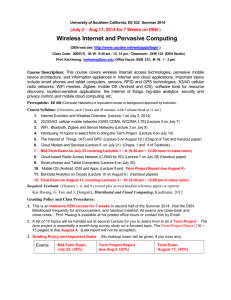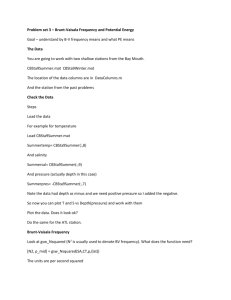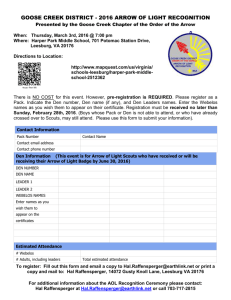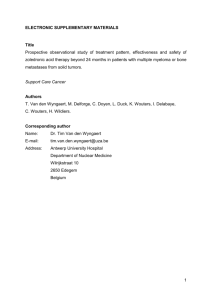Basic Properties of Rational Numbers
advertisement
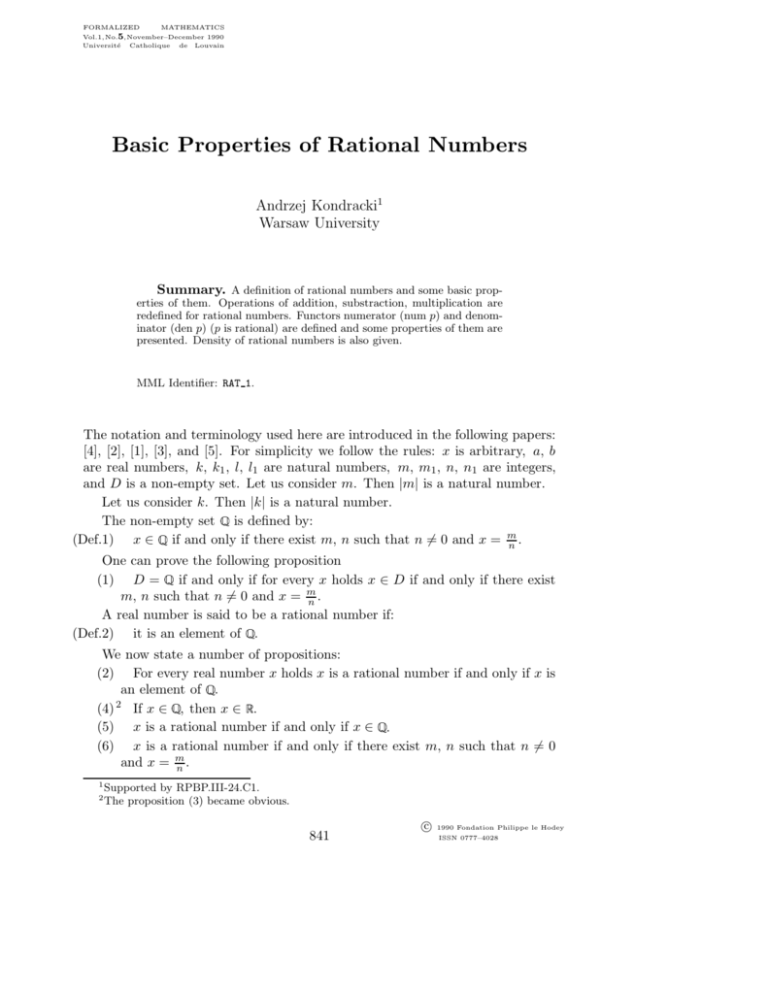
FORMALIZED MATHEMATICS Vol.1, No.5,November–December 1990 Université Catholique de Louvain Basic Properties of Rational Numbers Andrzej Kondracki1 Warsaw University Summary. A definition of rational numbers and some basic properties of them. Operations of addition, substraction, multiplication are redefined for rational numbers. Functors numerator (num p) and denominator (den p) (p is rational) are defined and some properties of them are presented. Density of rational numbers is also given. MML Identifier: RAT 1. The notation and terminology used here are introduced in the following papers: [4], [2], [1], [3], and [5]. For simplicity we follow the rules: x is arbitrary, a, b are real numbers, k, k1 , l, l1 are natural numbers, m, m1 , n, n1 are integers, and D is a non-empty set. Let us consider m. Then |m| is a natural number. Let us consider k. Then |k| is a natural number. The non-empty set is defined by: (Def.1) x ∈ if and only if there exist m, n such that n 6= 0 and x = m n. One can prove the following proposition (1) D = if and only if for every x holds x ∈ D if and only if there exist m, n such that n 6= 0 and x = m n. A real number is said to be a rational number if: (Def.2) it is an element of . We now state a number of propositions: (2) For every real number x holds x is a rational number if and only if x is an element of . 2 (4) If x ∈ , then x ∈ . (5) x is a rational number if and only if x ∈ . (6) x is a rational number if and only if there exist m, n such that n 6= 0 and x = m n. 1 2 Supported by RPBP.III-24.C1. The proposition (3) became obvious. 841 c 1990 Fondation Philippe le Hodey ISSN 0777–4028 842 Andrzej Kondracki (7) For every integer x holds x is a rational number. (8) For every natural number x holds x is a rational number. (9) 1 is a rational number and 0 is a rational number. (10) ⊆ . ⊆ . (11) ⊆ . (12) In the sequel p, q denote rational numbers. Next we state three propositions: (13) If x = kl and l 6= 0, then x is a rational number. (14) If x = m k and k 6= 0, then x is a rational number. k (15) If x = m and m 6= 0, then x is a rational number. Let us consider p, q. Then p · q is a rational number. Then p + q is a rational number. Then p − q is a rational number. Let us consider p, m. Then p + m is a rational number. Then p − m is a rational number. Then p · m is a rational number. Let us consider m, p. Then m + p is a rational number. Then m − p is a rational number. Then m · p is a rational number. Let us consider p, k. Then p+k is a rational number. Then p−k is a rational number. Then p · k is a rational number. Let us consider k, p. Then k +p is a rational number. Then k −p is a rational number. Then k · p is a rational number. Let us consider p. Then −p is a rational number. Then |p| is a rational number. One can prove the following propositions: (16) For all p, q such that q 6= 0 holds pq is a rational number. (17) (18) If k 6= 0, then kp is a rational number. p is a rational number. If m = 6 0, then m (19) If p 6= 0, then (20) For every p such that p 6= 0 holds k p is a rational number and (21) (22) (23) (24) (25) 1 p m p is a rational number. is a rational number. For every p such that p 6= 0 holds is a rational number. For all a, b such that a < b there exists p such that a < p and p < b. a < b if and only if there exists p such that a < p and p < b. For every p there exist m, k such that k 6= 0 and p = m k. m For every p there exist m, k such that k 6= 0 and p = k and for all n, l such that l 6= 0 and p = nl holds k ≤ l. Let us consider p. The functor den p yielding a natural number is defined by: (Def.3) p −1 den p 6= 0 and there exists m such that p = that k 6= 0 and p = nk holds den p ≤ k. We now state the proposition m den p and for all n, k such 843 Basic Properties of Rational Numbers m den p 6= 0 and there exists m such that p = den p and for all n, k such n that k 6= 0 and p = k holds den p ≤ k. Let us consider p. The functor num p yields an integer and is defined by: (Def.4) num p = den p · p. (26) One (27) (28) (29) (30) (31) (32) (33) (34) (35) (36) (37) can prove the following propositions: 0 < den p. 0 6= den p. 1 ≤ den p. 0 < den p−1 . 0 ≤ den p. 0 ≤ den p−1 . 0 6= den p−1 . 1 ≥ den p−1 . num p = den p · p and num p = p · den p. num p = 0 if and only if p = 0. p −1 and p = den p−1 · num p. p = num den p and p = num p · den p (38) If p 6= 0, then den p = (39) (40) (41) (42) (43) (44) (45) (46) (47) (48) (49) (50) (51) num p p . If p = m k and k 6= 0, then den p ≤ k. If p is an integer, then den p = 1 and num p = p. If num p = p or den p = 1, then p is an integer. num p = p if and only if den p = 1. If p is a natural number, then den p = 1 and num p = p. If num p = p or den p = 1 but 0 ≤ p, then p is a natural number. 1 < den p if and only if p is not an integer. 1 > den p−1 if and only if p is not an integer. num p = den p if and only if p = 1. num p = − den p if and only if p = −1. − num p = den p if and only if p = −1. p·m m·num p m·num p Suppose m 6= 0. Then p = num den p·m and p = den p·m and p = m·den p num p·m and p = m·den p . Suppose k 6= 0. Then p = p= num p·k den p·k and p = k·num p den p·k and p = and num p·k k·den p . Suppose p = m n and n 6= 0 and m1 6= 0. Then p = 1 1 ·m and p = m·m and p = m m1 ·n m1 ·n . (53) Suppose p = ml and l 6= 0 and m1 6= 0. Then p = m·m1 and p = mm11·m ·l and p = m1 ·l . (52) (54) k·num p k·den p Suppose p = nl and n 6= 0 and m1 6= 0. Then p = l·m1 m1 ·l and p = m . and p = m 1 ·n 1 ·n m·m1 n·m1 and p = m1 ·m n·m1 m·m1 l·m1 and p = m1 ·m l·m1 l·m1 n·m1 and p = m1 ·l n·m1 844 Andrzej Kondracki l·m1 l1 ·m1 m1 ·l l1 ·m1 (55) Suppose p = ll1 and l1 6= 0 and m1 6= 0. Then p = l·m1 and p = mm11·l·l1 and p = m . 1 ·l1 (56) Suppose p = m n and n 6= 0 and k 6= 0. Then p = k·m p = k·n and p = m·k k·n . m·k n·k and p = k·m n·k and (57) Suppose p = ml and l 6= 0 and k 6= 0. Then p = m·k p = k·m k·l and p = k·l . m·k l·k and p = k·m l·k and (58) Suppose p = nl and n 6= 0 and k 6= 0. Then p = l·k k·l and p = k·n . p = k·n l·k n·k and p = k·l n·k and (59) Suppose p = ll1 and l1 6= 0 and k 6= 0. Then p = ll·k and p = lk·l and 1 ·k 1 ·k l·k k·l p = k·l1 and p = k·l1 . If k 6= 0 and p = m k , then there exists l such that m = num p · l and k = den p · l. If p = m n and n 6= 0, then there exists m 1 such that m = num p · m1 and n = den p · m1 . For no l holds 1 < l and there exist m, k such that num p = m · l and den p = k · l. If p = m k and k 6= 0 and for no l holds 1 < l and there exist m 1 , k1 such that m = m1 · l and k = k1 · l, then k = den p and m = num p. p < −1 if and only if num p < − den p. p ≤ −1 if and only if num p ≤ − den p. p < −1 if and only if den p < − num p. p ≤ −1 if and only if den p ≤ − num p. −1 < p if and only if − den p < num p. p ≥ −1 if and only if num p ≥ − den p. −1 < p if and only if − num p < den p. p ≥ −1 if and only if den p ≥ − num p. p < 1 if and only if num p < den p. p ≤ 1 if and only if num p ≤ den p. 1 < p if and only if den p < num p. p ≥ 1 if and only if num p ≥ den p. p < 0 if and only if num p < 0. p ≤ 0 if and only if num p ≤ 0. 0 < p if and only if 0 < num p. p ≥ 0 if and only if num p ≥ 0. a < p if and only if a · den p < num p. a ≤ p if and only if a · den p ≤ num p. p < a if and only if num p < a · den p. a ≥ p if and only if a · den p ≥ num p. p = q if and only if den p = den q and num p = num q. (60) (61) (62) (63) (64) (65) (66) (67) (68) (69) (70) (71) (72) (73) (74) (75) (76) (77) (78) (79) (80) (81) (82) (83) (84) and p = 845 Basic Properties of Rational Numbers m1 If p = m n and n 6= 0 and q = n1 and n1 6= 0, then p = q if and only if m · n1 = m1 · n. (86) p < q if and only if num p · den q < num q · den p. (87) den(−p) = den p and num(−p) = − num p. (88) 0 < p and q = p1 if and only if num q = den p and den q = num p. (85) (89) p < 0 and q = 1 p if and only if num q = − den p and den q = − num p. References [1] Grzegorz Bancerek. The fundamental properties of natural numbers. Formalized Mathematics, 1(1):41–46, 1990. [2] Krzysztof Hryniewiecki. Basic properties of real numbers. Mathematics, 1(1):35–40, 1990. Formalized [3] Jan Popiolek. Some properties of functions modul and signum. Formalized Mathematics, 1(2):263–264, 1990. [4] Andrzej Trybulec. Tarski Grothendieck set theory. Formalized Mathematics, 1(1):9–11, 1990. [5] Michal J. Trybulec. Integers. Formalized Mathematics, 1(3):501–505, 1990. Received July 10, 1990

